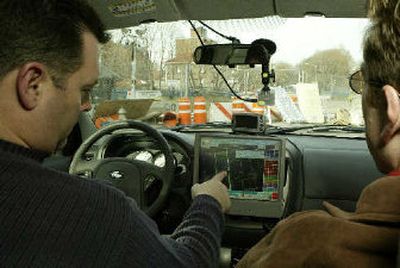In the right direction

Editor’s note: As motorists jettison their fold-up paper maps in favor of the more detailed point-and-click variety, mapping companies must improve their offerings. This is the first of two stories examining the technology needed to keep up with the demand.
SECAUCUS, N.J. — As Chris Arcari gets off the New Jersey Turnpike’s brand new Exit 15X, green arrows join on a flat-screen monitor inside his SUV to form the beginnings of the ramp’s existence on a digital map.
In a white Ford Escape fitted with a video camera, a GPS receiver and a laptop, Arcari and partner Rob Ditkho work to maintain the freshness and accuracy of mapping databases on which millions rely.
One wrong turn and, well, you get the picture.
As mapping technologies proliferate on Web sites, in mobile devices and inside automobiles, the work of these modern cartographers is essential.
During their December excursion off Exit 15X, the two men discover three new streets and a delivery access road.
“Times like these, we just explore,” Arcari says as he passes a new commuter rail station responsible for the new streets. “It’s our version of finding a brave new world. We’ll drive it until it connects to some point (already) in the database.”
Riding shotgun, Ditkho uses his pen tablet to denote an overpass, which appears as brackets on the display above the four-wheel-drive vehicle’s gear shift. Later, he writes in the name of a new street, South Road.
Information gleaned from the green arrows, hand markings and video images ultimately go into databases maintained by Navteq Inc. and sent quarterly to such Internet mapping providers as America Online Inc.’s MapQuest, Yahoo Inc., Microsoft Corp. and Google Inc. and in-car navigation developers like TomTom International BV.
Developers of the map applications can then apply their own touches, such that directions offered by Yahoo between the same two points may differ from MapQuest’s, even though both use the same data from Navteq and its main competitor, Tele Atlas NV.
Online maps have come a long way.
“Users even five years ago were still just amazed you can get driving directions from point A to point B,” says Jeremy Kreitler, Yahoo’s senior product manager for maps. “They were OK if every once in a while, it took you down the wrong street or didn’t know about a new housing development.”
David Reese, 61, who lives in Florida’s growing Sarasota County, had to call a friend for directions recently because the man’s street was so new. Although digital maps improve mightily on the fold-out paper variety, Reese says, people have become spoiled.
“People expect everything to be 100 percent exact because things are so close to being so,” he says. “When something doesn’t work 100 percent, they complain.”
No longer satisfied with driving directions, consumers are also demanding information on a neighborhood’s restaurants, public transportation options and even real-time traffic conditions.
From the outside, save for a Global Positioning System antenna that resembles a police siren on top, the Escape looks like any other SUV.
But in the back is a bolted cabinet containing a GPS receiver attached to the antenna, a laptop docking station, power supply and cables snaking through the vehicle’s interior to connect with the computer display and video camera up front.
The GPS setup feeds latitude and longitude information several times a second, plotted on the display as green arrows that connect to form digital roads. The camera captures three frames a second, enough to reconstruct road signs and other details.
In the databases, roads are broken into line segments, each carrying as many as 160 attributes — such things as road quality (ranging from 1 for major arteries to 5 for local streets), presence of a divider or center turn lanes, speed limits and addresses of buildings along each side.
There are fields to note one-way and turn restrictions, and whether they are limited to certain times, such as weekdays only between 4 and 7 p.m. Any special rules for trucks, taxis and even bikers and pedestrians can be marked.
Tele Atlas operates in a similar fashion.
There, 6 million miles of North American roads appear as 60 million line segments, each described by where it starts and ends and how it curves. Divided highways and ramps have separate segments, as do feeder roads that parallel a main thoroughfare. There’s also data on landmarks, statues and other points of interest.
Both companies have been digitizing maps for about two decades, but only recently have GPS units, video cameras and laptops become central to the task.
“Six or seven years ago,” Ditkho said, “we were writing on paper plots.”